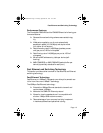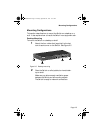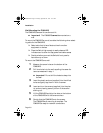Introduction
Page 1-4
Switching Technology
An Ethernet switch is a device that can direct network traffic among
several Ethernet and Fast Ethernet networks.
A switch increases network capacity and decreases network loading
by making it possible for a LAN to be divided into different
segments.
Switch acts as a bridge between network segments
A switch acts as a high-speed selective bridge between individual seg-
ments.
Traffic that needs to go from one segment to another is automatically
forwarded by a switch, without interfering with any other segments.
This allows the total network capacity to be multiplied, while decreas-
ing network loading.
To ensure network reliability, a switch monitors each of its ports for
signal quality and automatically disconnects stations transmitting
excessive noise, reconnecting them when the problem is resolved.
A switch automatically truncates data packets that exceed the maxi-
mum length for IEEE 802.3u, preventing a device from blocking the
network by transmitting continuous data streams or extra-long pack-
ets.
Switch supports network expansion
For Fast Ethernet networks, a switch is an effective way of eliminating
problems of chaining hubs beyond the “two-repeater limit.”
A switch can be used to split parts of the network into different colli-
sion domains, making it possible to expand your Fast Ethernet net-
work beyond the 205 meter network diameter limit for 100BASE-TX
networks.
Switches supporting both traditional 10Mbps Ethernet and 100Mbps
Fast Ethernet are also ideal for bridging between existing 10Mbps net-
works and new 100Mbps networks.
FRCH1Book Page 4 Thursday, September 25, 1997 11:23 AM


















